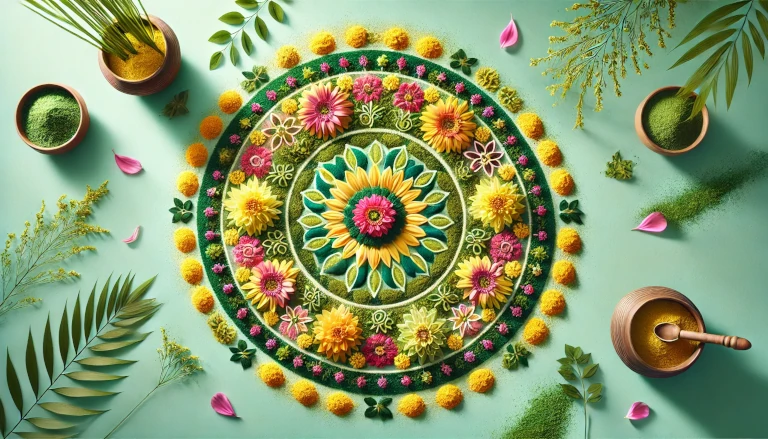Rangoli is a beautiful, traditional art form that adds color and vibrancy to festivals, weddings, and special occasions. However, many modern Rangoli designs use synthetic colors that can harm the environment. Fortunately, eco-friendly Rangoli offers a sustainable way to keep this cherished tradition alive while respecting the planet. Using natural and biodegradable materials, you can create stunning Rangoli designs that are both vibrant and environmentally friendly.
In this blog post, we’ll explore eco-friendly Rangoli ideas, materials, and tips for a greener celebration. Whether you’re preparing for Diwali, Pongal, or a family function, eco-friendly Rangoli will add beauty to your celebration while promoting sustainability.
Why Choose Eco-Friendly Rangoli? 🌱🌼
Eco-friendly Rangoli uses natural materials that are biodegradable and safe for the environment. By opting for sustainable Rangoli designs, you’re helping to reduce plastic waste, prevent pollution, and promote the use of natural resources. Eco-friendly Rangoli is not only beautiful but also supports traditional practices that honor nature.
Materials for Eco-Friendly Rangoli 🌿✨
To create an eco-friendly Rangoli, choose materials that are natural, non-toxic, and biodegradable. Here are some popular options:
1. Flowers and Petals 🌸🌼
Using flowers and petals is a classic and eco-friendly way to create Rangoli. Flowers like marigolds, roses, jasmine, and lotus add vibrant colors and a pleasant fragrance. Once the celebration is over, the flowers can be composted, reducing waste.
- Example: Use a mix of marigold petals for yellow, rose petals for red, and jasmine for white to create a colorful floral Rangoli.
2. Colored Powders Made from Natural Ingredients 🌈🌾
You can use colored powders made from turmeric for yellow, sindoor for red, and rice flour for white. These natural colors are safe for the environment and can be easily washed away without harming plants or animals.
3. Grains and Pulses 🌾🍚
Grains like rice, millet, and lentils are perfect for eco-friendly Rangoli. They are readily available, biodegradable, and can be used to create intricate patterns and designs. Grains also add texture to the Rangoli, making it unique and eye-catching.
- Example: Use green moong dal for green, yellow split peas for yellow, and white rice for white to form colorful patterns.
4. Fruit and Vegetable Peels 🍊🍃
For a more creative approach, use fruit and vegetable peels to make Rangoli. Peels from oranges, lemons, and pomegranate can add different colors and textures to your design. This is a great way to reuse kitchen scraps and make your Rangoli more sustainable.
Eco-Friendly Rangoli Design Ideas 🎨🌸
Here are some simple and eco-friendly Rangoli design ideas to get you started:
1. Floral Circle Rangoli 🌸🔄
Create a circular Rangoli using flower petals arranged in concentric rings. This design is easy to create and can be adapted to any space. Use different flowers to create layers of contrasting colors for a beautiful effect.
2. Traditional Patterns with Rice and Grains 🌾🌀
Use rice and pulses to form traditional Rangoli patterns like paisleys, swirls, and geometric shapes. You can add colored powders made from turmeric and sindoor to enhance the design.
3. Mandala with Leaves and Flowers 🍃🌼
Mandala designs are perfect for creating intricate and symmetrical Rangoli. Use leaves like mango leaves and neem leaves along with flower petals to make a nature-inspired Mandala Rangoli.
Tips for Making Eco-Friendly Rangoli 🌱🖌️
- Plan Your Design: Before starting, sketch out your design on paper. This will help you visualize the final result and ensure you have enough materials.
- Use Reusable Tools: Instead of disposable plates or spoons, use reusable tools like scoops or sieves to sprinkle powders and place petals.
- Compost Your Rangoli: After the celebration, gather the flowers, leaves, and grains used in your Rangoli and compost them. This way, your Rangoli waste will turn into nutrient-rich soil for plants.
Real-Life Example: Eco-Friendly Rangoli for Diwali Celebrations 🪔🌸
Eco-friendly Rangoli is becoming popular during Diwali, as many people are choosing sustainable options to celebrate the festival of lights. For instance, using marigold and rose petals along with rice flour to create vibrant designs is a common practice. This method not only respects the environment but also enhances the beauty of traditional Diwali celebrations by adding natural elements to the decor.
Benefits of Eco-Friendly Rangoli 🌍🌈
Using eco-friendly Rangoli offers several benefits:
- Reduces Environmental Impact: By avoiding synthetic colors, you’re helping to prevent pollution and minimize waste.
- Promotes Health and Safety: Natural materials are non-toxic, making them safer for you and your family, especially for young children who might come into contact with the Rangoli.
- Supports Sustainable Practices: Eco-friendly Rangoli encourages the use of renewable resources and helps to preserve traditional arts in a way that respects nature.
Celebrate with Eco-Friendly Rangoli 🌸💚
Eco-friendly Rangoli is a beautiful way to honor traditions while making mindful choices for the environment. By using natural materials like flowers, grains, and biodegradable powders, you can create stunning designs that celebrate your values and love for nature. Whether it’s for Diwali, Pongal, or any special occasion, eco-friendly Rangoli offers a sustainable and colorful way to decorate your home.
This festive season, embrace the beauty of nature with eco-friendly Rangoli and let your designs reflect your commitment to a greener planet.
Discover more from Green Ecosystem - Renewable Energy, Agriculture, and Environmental Sustainability
Subscribe to get the latest posts sent to your email.


